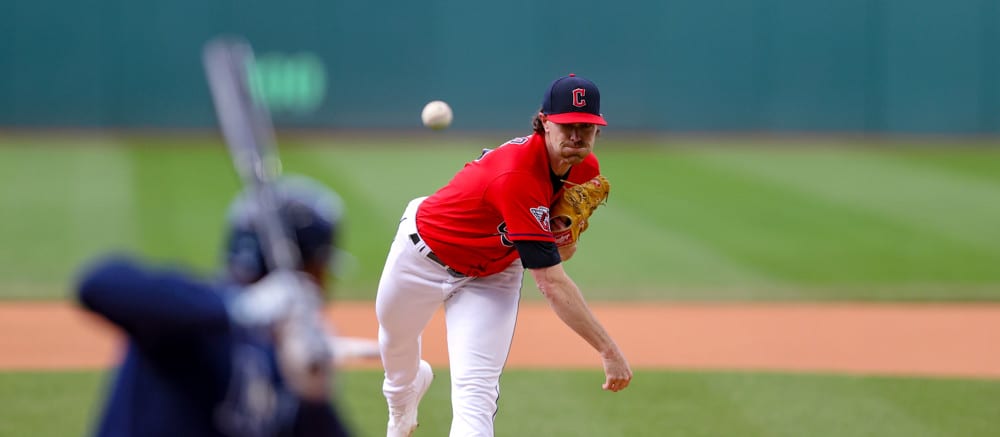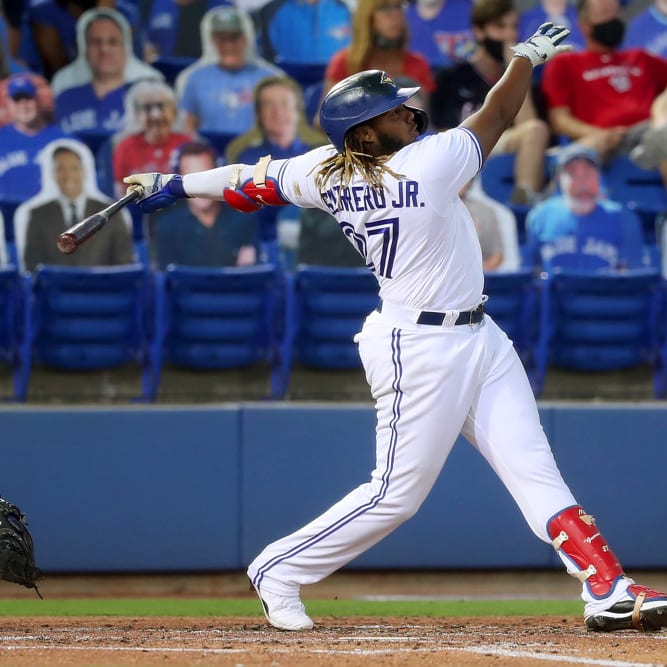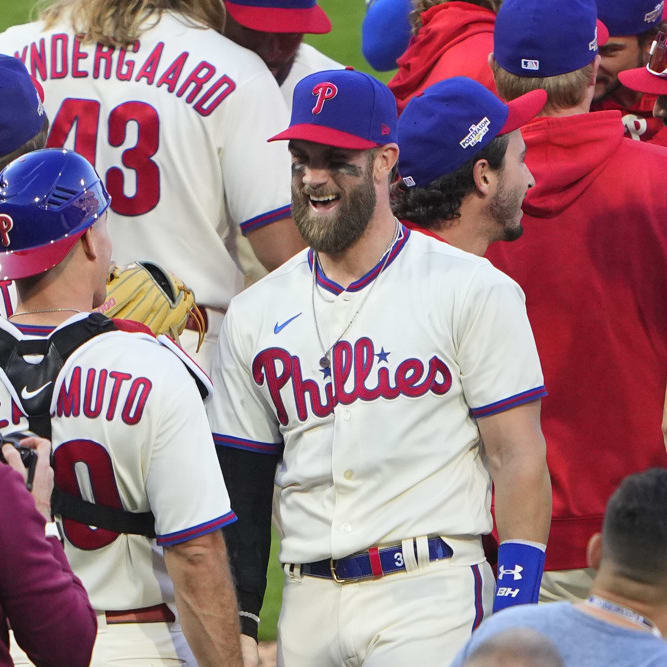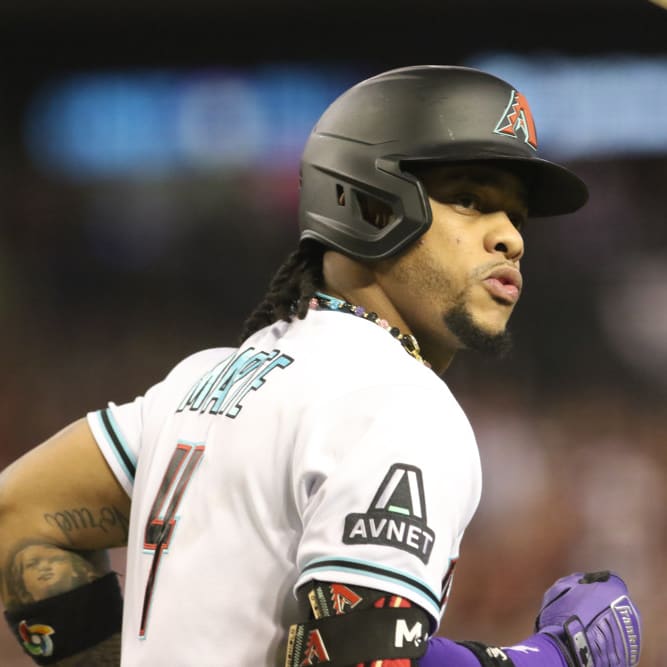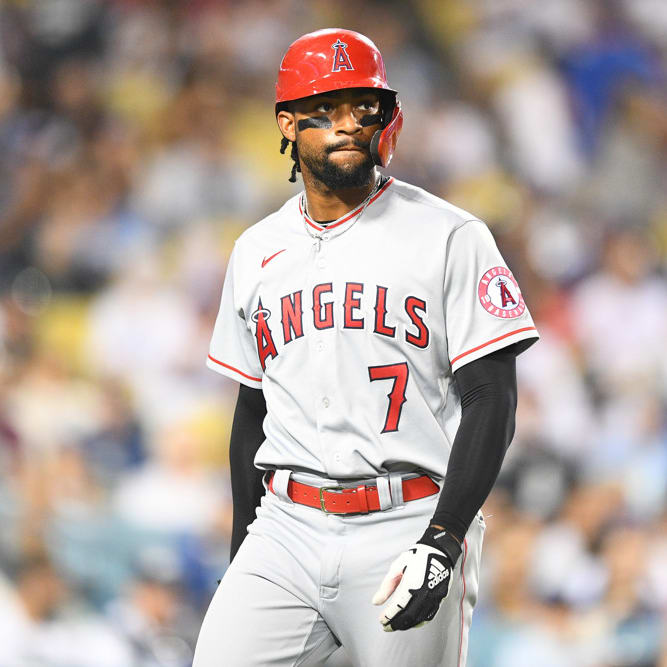This article is part of our MLB Barometer series.
The first few weeks of the season are one of the best times of the year as a baseball fan. After nearly five months without a meaningful game, there's suddenly so much baseball being played that you couldn't possibly watch it all even if you refused to sleep. Even if your team gets off to a slow start, the return of background-noise baseball is worth celebrating.
Those same first few weeks aren't an uncomplicated positive for fantasy players, however. In many ways, they're just confusing. We have hundreds of new performances to analyze, which is a lot more fun than spending yet another month looking at last year's stats, but there's so much noise mixed in with all the signal in these small-sample stats that it's very easy to be misled.
Take, for example, two players who were on my shortlist for this week's article but who ultimately wound up getting cut. Shota Imanaga took a no-hitter into the sixth inning of his MLB debut on Monday, striking out nine and walking none while allowing just two hits in six shutout frames. That's "riser" material, but that performance came against the lowly Rockies and saw Imanaga fail to generate a single groundball, which raises fears that his homer troubles could follow him across the Pacific. What do we do about it? Wait at least one more week before thinking of him all that differently is my advice.
Meanwhile, Elly De La Cruz has struck out in 48 percent of his
The first few weeks of the season are one of the best times of the year as a baseball fan. After nearly five months without a meaningful game, there's suddenly so much baseball being played that you couldn't possibly watch it all even if you refused to sleep. Even if your team gets off to a slow start, the return of background-noise baseball is worth celebrating.
Those same first few weeks aren't an uncomplicated positive for fantasy players, however. In many ways, they're just confusing. We have hundreds of new performances to analyze, which is a lot more fun than spending yet another month looking at last year's stats, but there's so much noise mixed in with all the signal in these small-sample stats that it's very easy to be misled.
Take, for example, two players who were on my shortlist for this week's article but who ultimately wound up getting cut. Shota Imanaga took a no-hitter into the sixth inning of his MLB debut on Monday, striking out nine and walking none while allowing just two hits in six shutout frames. That's "riser" material, but that performance came against the lowly Rockies and saw Imanaga fail to generate a single groundball, which raises fears that his homer troubles could follow him across the Pacific. What do we do about it? Wait at least one more week before thinking of him all that differently is my advice.
Meanwhile, Elly De La Cruz has struck out in 48 percent of his plate appearances thus far, and for a player whose severe contact concerns could sink an otherwise outstanding profile, that easily could land him on the "fallers" list. However, he's also grabbed at least one hit in all six games and has attempted three steals (going 2-for-3). If you thought that the Reds' other absences would buy De La Cruz time to work through his swing-and-miss issues and that he would continue to run a ton even while struggling at the dish, then his first week has gone more or less exactly as expected.
Those are just two examples that demonstrate that we're not going to get conclusive answers regarding who's in line for a good or a difficult season based on just one week's worth of stats, even if those stats are relatively extreme. The focus this time of year is still primarily on players whose roles have changed for better or worse, though we shouldn't ignore a few of the most notable early performances, particularly if those performances showcase a new skill.
RISERS
 Shane Bieber, SP, Guardians: There was a time not too long ago when Bieber was the best pitcher in baseball. In the shortened 2020 season, Bieber rode a 41.1 percent strikeout rate to a 1.63 ERA and a Cy Young award. He's still only 28 years old, but his stock has fallen a considerable amount after three seasons in which he battled injuries and lost effectiveness, with his strikeout rate dropping to 33.1 percent, then 25.0 and then finally 20.1 percent last season. That loss of whiffs matched a loss of velocity, with his fastball coming in at 91.6 mph over the last two seasons after sitting at 94.3 mph in 2020. It was reasonable to conclude that he was simply not the same guy as he used to be. But Bieber went to Driveline over the winter in an effort to recapture that lost velocity, and his results through two outings could hardly be more encouraging. Away games in pitchers' paradises in Oakland and Seattle certainly help, but it takes more than just park factors to get him to a 20:1 K:BB across 12 shutout innings. He does indeed have a bit more velocity, as well, with his fastball creeping back up to 92.5 mph. Two strong starts don't do anything to address the durability concerns that still surround Bieber, but they go a long way toward restoring the faith that he's still an elite starter when healthy.
Shane Bieber, SP, Guardians: There was a time not too long ago when Bieber was the best pitcher in baseball. In the shortened 2020 season, Bieber rode a 41.1 percent strikeout rate to a 1.63 ERA and a Cy Young award. He's still only 28 years old, but his stock has fallen a considerable amount after three seasons in which he battled injuries and lost effectiveness, with his strikeout rate dropping to 33.1 percent, then 25.0 and then finally 20.1 percent last season. That loss of whiffs matched a loss of velocity, with his fastball coming in at 91.6 mph over the last two seasons after sitting at 94.3 mph in 2020. It was reasonable to conclude that he was simply not the same guy as he used to be. But Bieber went to Driveline over the winter in an effort to recapture that lost velocity, and his results through two outings could hardly be more encouraging. Away games in pitchers' paradises in Oakland and Seattle certainly help, but it takes more than just park factors to get him to a 20:1 K:BB across 12 shutout innings. He does indeed have a bit more velocity, as well, with his fastball creeping back up to 92.5 mph. Two strong starts don't do anything to address the durability concerns that still surround Bieber, but they go a long way toward restoring the faith that he's still an elite starter when healthy.
 Abner Uribe, RP, Brewers: Devin Williams was diagnosed with a pair of stress fractures in his back in mid-March, an injury that is expected to cost him at least half the season. The Brewers kept their cards close to their chest as far as his potential replacement, and there wasn't much to separate the leading candidates, at least judging by their 2023 stats:
Abner Uribe, RP, Brewers: Devin Williams was diagnosed with a pair of stress fractures in his back in mid-March, an injury that is expected to cost him at least half the season. The Brewers kept their cards close to their chest as far as his potential replacement, and there wasn't much to separate the leading candidates, at least judging by their 2023 stats:
| Name | IP | SV | ERA | WHIP | K% | BB% | GB% | SIERA |
|---|---|---|---|---|---|---|---|---|
| Joel Payamps | 70.2 | 3 | 2.55 | 1.05 | 26.8% | 5.9% | 45.9% | 3.24 |
| Abner Uribe | 30.2 | 1 | 1.76 | 1.17 | 30.7% | 15.7% | 53.0% | 4.05 |
| Trevor Megill | 34.2 | 0 | 3.63 | 1.36 | 35.1% | 8.1% | 30.5% | 2.75 |
Uribe has the most exciting stuff in the group and the brightest future, but his significant command issues as a rookie meant it would have been no surprise if the team turned to one of the two veterans as a fill-in closer and allowed Uribe to keep working on his control in the seventh or eighth inning. Instead, the Brewers have used Uribe like a very conventional closer. In the season opener, it was Megill in the seventh, Payamps in the eighth and Uribe in the ninth. In game two, it was Megill in the seventh again, Bryse Wilson and Hoby Milner in the eighth, and Uribe again in the ninth. Payamps got the save the next day with Uribe unavailable, but then it was Milner-Payamps-Uribe in the final three frames in game four. That early usage means Uribe can safely be treated as a true closer, not merely a committee lead, and with Williams a candidate to be traded at the deadline once healthy, Uribe could even keep the title all season.
 Maikel Garcia, 3B, Royals: Generally speaking, pitchers can rise and fall for performance-based reasons after just a week's worth of games, but it's hard for a hitter to do that. Generally, the hitters I feature in the first week or two have earned a "riser" or "faller" designation based on the fact that their roles are larger or smaller than expected. When one of the most widely hyped sleepers of the winter starts the year like this, though, we have to take notice. Garcia's sleeper appeal was based off the fact that he did just about everything but hit for power as a rookie last year, giving him a fine floor if he took no steps forward as a sophomore and a high ceiling should the power start to emerge. Garcia's lack of power last season was rather extreme (just four homers in 515 plate appearances), but it wasn't due to a lack of strength, as his hard-hit rate sat in the 93rd percentile. His swing simply wasn't geared for loft, with his 27.4 percent flyball rate ranking seventh lowest among hitters with at least 500 plate appearances. That flyball rate is up to 47.4 percent through six games, with Garcia homering three times. It will take more than one hot week before we can say for sure that Garcia is a new man this season and has added enough power to make him a legitimate all-around threat (remember Yandy Diaz last April?), but we couldn't have asked for a much better start.
Maikel Garcia, 3B, Royals: Generally speaking, pitchers can rise and fall for performance-based reasons after just a week's worth of games, but it's hard for a hitter to do that. Generally, the hitters I feature in the first week or two have earned a "riser" or "faller" designation based on the fact that their roles are larger or smaller than expected. When one of the most widely hyped sleepers of the winter starts the year like this, though, we have to take notice. Garcia's sleeper appeal was based off the fact that he did just about everything but hit for power as a rookie last year, giving him a fine floor if he took no steps forward as a sophomore and a high ceiling should the power start to emerge. Garcia's lack of power last season was rather extreme (just four homers in 515 plate appearances), but it wasn't due to a lack of strength, as his hard-hit rate sat in the 93rd percentile. His swing simply wasn't geared for loft, with his 27.4 percent flyball rate ranking seventh lowest among hitters with at least 500 plate appearances. That flyball rate is up to 47.4 percent through six games, with Garcia homering three times. It will take more than one hot week before we can say for sure that Garcia is a new man this season and has added enough power to make him a legitimate all-around threat (remember Yandy Diaz last April?), but we couldn't have asked for a much better start.
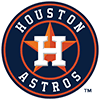 Ronel Blanco, SP, Astros: How can I not include the man who just threw a no-hitter as a riser? Blanco's dominant performance against the Blue Jays on Monday serves as a reminder that no-hitters come out of nowhere, but it could also be a reminder that pitchers can change quickly, and the player who put up their previous numbers may not be the player they are now. Blanco signed as a 22-year-old international free agent back in 2016, six years older than most signees, and he didn't reach the majors until his age-28 season. He didn't make an Opening Day rotation until this year, his age-30 campaign, and it took multiple injuries to get him there. But he made a key change in his start against Toronto, throwing his changeup 34.3 percent of the time after using it just 8.8 percent of the time prior to that point. He trusted the pitch against both righties and lefties, having previously used it almost exclusively against left-handers. Blanco with three pitches he can trust could be decidedly different than Blanco with just a fastball and a slider, so it's worth picking him up to see whether his no-no was merely the start of a late-career breakout.
Ronel Blanco, SP, Astros: How can I not include the man who just threw a no-hitter as a riser? Blanco's dominant performance against the Blue Jays on Monday serves as a reminder that no-hitters come out of nowhere, but it could also be a reminder that pitchers can change quickly, and the player who put up their previous numbers may not be the player they are now. Blanco signed as a 22-year-old international free agent back in 2016, six years older than most signees, and he didn't reach the majors until his age-28 season. He didn't make an Opening Day rotation until this year, his age-30 campaign, and it took multiple injuries to get him there. But he made a key change in his start against Toronto, throwing his changeup 34.3 percent of the time after using it just 8.8 percent of the time prior to that point. He trusted the pitch against both righties and lefties, having previously used it almost exclusively against left-handers. Blanco with three pitches he can trust could be decidedly different than Blanco with just a fastball and a slider, so it's worth picking him up to see whether his no-no was merely the start of a late-career breakout.
 Garrett Crochet, SP, White Sox: Crochet has had one of the strangest possible starts to his career, making him almost a complete afterthought throughout most of draft season, despite the fact that he's a recent first-round pick who was named his team's Opening Day starter. Crochet was selected 11th overall in the 2020 draft, and as an advanced college pitcher in a year with no minor-league season, he reached the majors that same year, tossing six scoreless innings of relief. He spent all of 2021 in the big-league bullpen and didn't make his first minor-league appearance until 2023, in a rehab outing as he worked his way back from Tommy John surgery, which wiped out all of 2022 and a sizable portion of last season. Now that he's finally unleashed as a starter, we'll see if the stuff that led both to his high draft spot and his career 26.9 percent strikeout rate in relief is able to overcome the control questions that led to his 12.7 percent walk rate and raised concerns about his long-term viability in the rotation. If his 1.38 ERA and 16:1 K:BB through two starts are any indication, he's going to be just fine. One word of caution: His 25.2 total innings this season (majors, minors and spring altogether) are already more than the 25 he threw last year, so expect the White Sox to shift him to the bullpen at some point this season for workload concerns, even if he continues to perform.
Garrett Crochet, SP, White Sox: Crochet has had one of the strangest possible starts to his career, making him almost a complete afterthought throughout most of draft season, despite the fact that he's a recent first-round pick who was named his team's Opening Day starter. Crochet was selected 11th overall in the 2020 draft, and as an advanced college pitcher in a year with no minor-league season, he reached the majors that same year, tossing six scoreless innings of relief. He spent all of 2021 in the big-league bullpen and didn't make his first minor-league appearance until 2023, in a rehab outing as he worked his way back from Tommy John surgery, which wiped out all of 2022 and a sizable portion of last season. Now that he's finally unleashed as a starter, we'll see if the stuff that led both to his high draft spot and his career 26.9 percent strikeout rate in relief is able to overcome the control questions that led to his 12.7 percent walk rate and raised concerns about his long-term viability in the rotation. If his 1.38 ERA and 16:1 K:BB through two starts are any indication, he's going to be just fine. One word of caution: His 25.2 total innings this season (majors, minors and spring altogether) are already more than the 25 he threw last year, so expect the White Sox to shift him to the bullpen at some point this season for workload concerns, even if he continues to perform.
FALLERS
 Esteury Ruiz, OF, Athletics: Ruiz earned his fair share of "Mallex Smith" comps during draft season from those who wanted no part of him on their rosters, but even Smith gave us two consecutive seasons with 40-plus steals. Will Ruiz's 67 steals last season wind up being the only time he eclipses that mark? He made Oakland's Opening Day roster, but only as the short side of a platoon in left field, and he was optioned Monday after just eight plate appearances. That demotion seemingly had little to do with his performance, as he had a 1.232 OPS and a steal in his microscopic sample, with manager Mark Kotsay instead saying that Ruiz had only made the roster due to a late-spring knee injury for Miguel Andujar, which naturally meant Ruiz was the one to make way when the team claimed Tyler Nevin off waivers. These are the sorts of players Ruiz is competing with in real-life baseball, a stark contrast to the players drafted near him in fantasy baseball. Ruiz has bottom-of-the-scale power (with an 18.9 percent hard hit rate for his career) and his speed doesn't translate to good defense. While it may have been tempting to dream on Ruiz's speed and imagine him threatening triple digits while playing every day, it should now be clear that a sharp decrease in playing time from his 497 trips to the plate last year is far more likely than a sharp increase.
Esteury Ruiz, OF, Athletics: Ruiz earned his fair share of "Mallex Smith" comps during draft season from those who wanted no part of him on their rosters, but even Smith gave us two consecutive seasons with 40-plus steals. Will Ruiz's 67 steals last season wind up being the only time he eclipses that mark? He made Oakland's Opening Day roster, but only as the short side of a platoon in left field, and he was optioned Monday after just eight plate appearances. That demotion seemingly had little to do with his performance, as he had a 1.232 OPS and a steal in his microscopic sample, with manager Mark Kotsay instead saying that Ruiz had only made the roster due to a late-spring knee injury for Miguel Andujar, which naturally meant Ruiz was the one to make way when the team claimed Tyler Nevin off waivers. These are the sorts of players Ruiz is competing with in real-life baseball, a stark contrast to the players drafted near him in fantasy baseball. Ruiz has bottom-of-the-scale power (with an 18.9 percent hard hit rate for his career) and his speed doesn't translate to good defense. While it may have been tempting to dream on Ruiz's speed and imagine him threatening triple digits while playing every day, it should now be clear that a sharp decrease in playing time from his 497 trips to the plate last year is far more likely than a sharp increase.
 A.J. Puk, SP, Marlins: Spring injuries to Eury Perez (elbow), Braxton Garrett (shoulder) and Edward Cabrera (shoulder) allowed Puk to open the year in the Marlins' rotation, giving him the chance to make his first major-league start eight seasons after being selected eighth overall in the 2016 draft. He was a popular late-round target among drafters willing to take a chance that his success as a reliever (he had a 3.51 ERA, 29.5 percent strikeout rate and 6.9 percent walk rate across the last two seasons) would translate into success as a starter. That may have been a chance worth taking, but if his first two starts are any indication, his best path to fantasy relevance this season might be for him to return to the bullpen and work his way toward the top of the closer depth chart. His first start was awful, as he walked six batters and struck out just one in two innings of work, allowing four runs on three hits. He improved his K:BB to 5:3 in his second outing but completed just four frames, allowing four runs (two earned) on five hits. His velocity was down multiple ticks, as is common for a pitcher asked to go deeper into games, and his control deserted him as well. He looks, in other words, like a reliever trying to start. He lines up for a tough outing at Yankee stadium next Tuesday and could be back in the bullpen not long after that, with Garrett and Cabrera working their way back to good health.
A.J. Puk, SP, Marlins: Spring injuries to Eury Perez (elbow), Braxton Garrett (shoulder) and Edward Cabrera (shoulder) allowed Puk to open the year in the Marlins' rotation, giving him the chance to make his first major-league start eight seasons after being selected eighth overall in the 2016 draft. He was a popular late-round target among drafters willing to take a chance that his success as a reliever (he had a 3.51 ERA, 29.5 percent strikeout rate and 6.9 percent walk rate across the last two seasons) would translate into success as a starter. That may have been a chance worth taking, but if his first two starts are any indication, his best path to fantasy relevance this season might be for him to return to the bullpen and work his way toward the top of the closer depth chart. His first start was awful, as he walked six batters and struck out just one in two innings of work, allowing four runs on three hits. He improved his K:BB to 5:3 in his second outing but completed just four frames, allowing four runs (two earned) on five hits. His velocity was down multiple ticks, as is common for a pitcher asked to go deeper into games, and his control deserted him as well. He looks, in other words, like a reliever trying to start. He lines up for a tough outing at Yankee stadium next Tuesday and could be back in the bullpen not long after that, with Garrett and Cabrera working their way back to good health.
 Tanner Scott, RP, Marlins: Scott had a rocky start to spring, with a 3:7 K:BB and 10 runs allowed in 1.2 innings across his first four appearances, creating speculation that Andrew Nardi could take his spot. Nardi's own 7:7 K:BB in spring training and Scott's 4:0 K:BB with no runs allowed over his final four spring games cooled that talk, but Scott's struggles returned in a big way as soon as the games started to matter again. It's only been three appearances, but Scott has walked a third of the batters he's faced, with his 5:6 K:BB and 2.33 WHIP standing in stark contrast to his 3.00 ERA. The Marlins have yet to record a win, and Scott hasn't actually had the opportunity to blow a save yet, but he does have two losses. He entered in a tie game in all three of his outings but was able to keep the game tied just once. No one else in the Marlins' bullpen is pitching well at the moment, so these three poor outings by no means indicate Scott's closer job is under imminent threat nor that he should be dropped. Still, it serves as a reminder that Scott has had a very up and down career and has never remained reliable long enough to earn more than 20 saves in a season. It's easy to envision him pitching his way into and out of the closer role throughout the year.
Tanner Scott, RP, Marlins: Scott had a rocky start to spring, with a 3:7 K:BB and 10 runs allowed in 1.2 innings across his first four appearances, creating speculation that Andrew Nardi could take his spot. Nardi's own 7:7 K:BB in spring training and Scott's 4:0 K:BB with no runs allowed over his final four spring games cooled that talk, but Scott's struggles returned in a big way as soon as the games started to matter again. It's only been three appearances, but Scott has walked a third of the batters he's faced, with his 5:6 K:BB and 2.33 WHIP standing in stark contrast to his 3.00 ERA. The Marlins have yet to record a win, and Scott hasn't actually had the opportunity to blow a save yet, but he does have two losses. He entered in a tie game in all three of his outings but was able to keep the game tied just once. No one else in the Marlins' bullpen is pitching well at the moment, so these three poor outings by no means indicate Scott's closer job is under imminent threat nor that he should be dropped. Still, it serves as a reminder that Scott has had a very up and down career and has never remained reliable long enough to earn more than 20 saves in a season. It's easy to envision him pitching his way into and out of the closer role throughout the year.
 Alex Lange, RP, Tigers: I could have had Lange's teammate Jason Foley as one of this week's risers, but the way the Tigers have managed their bullpen thus far makes it seem like Lange is falling far more than Foley is rising. Foley has both of the team's saves, but the way he's been used makes it seem like he may be nothing more than the lead man in a committee. Both of Foley's saves have seen him record just two outs, with a left-hander (Andrew Chafin or Tyler Holton) sticking around to face a lefty to begin the ninth inning after finishing the eighth. That's the type of usage pattern you see when a manager is looking to play the matchups, not the usage you expect in a bullpen with a rigid hierarchy. Combine that with the fact that Foley struck out just 18.0 percent of opposing batters prior to this season (which admittedly was prior to a jump in velocity this winter), and I'm not yet ready to anoint him a true closer. But whether Foley stands alone atop the Tigers' high-leverage group or merely leads a corps of late-inning weapons, it's not clear that Lange is anywhere near the picture. His only appearance to date saw him enter with a tie game in the seventh and proceed to walk three of the four batters he faced. Given that he walked 15.6 percent of opposing batters last season while struggling to a 4.41 SIERA, it's no surprise that he doesn't seem to be in the high-leverage mix this season even though he wound up with 26 saves last year.
Alex Lange, RP, Tigers: I could have had Lange's teammate Jason Foley as one of this week's risers, but the way the Tigers have managed their bullpen thus far makes it seem like Lange is falling far more than Foley is rising. Foley has both of the team's saves, but the way he's been used makes it seem like he may be nothing more than the lead man in a committee. Both of Foley's saves have seen him record just two outs, with a left-hander (Andrew Chafin or Tyler Holton) sticking around to face a lefty to begin the ninth inning after finishing the eighth. That's the type of usage pattern you see when a manager is looking to play the matchups, not the usage you expect in a bullpen with a rigid hierarchy. Combine that with the fact that Foley struck out just 18.0 percent of opposing batters prior to this season (which admittedly was prior to a jump in velocity this winter), and I'm not yet ready to anoint him a true closer. But whether Foley stands alone atop the Tigers' high-leverage group or merely leads a corps of late-inning weapons, it's not clear that Lange is anywhere near the picture. His only appearance to date saw him enter with a tie game in the seventh and proceed to walk three of the four batters he faced. Given that he walked 15.6 percent of opposing batters last season while struggling to a 4.41 SIERA, it's no surprise that he doesn't seem to be in the high-leverage mix this season even though he wound up with 26 saves last year.
Young Injury-Prone Third Basemen: It hasn't been a good week to be a young third baseman with plenty of talent but a spotty health track record. On Opening Day, Royce Lewis followed up a home run in his first plate appearance of the season with an injury in his second, as he strained his right quadriceps while rounding second base and will be shut down from baseball activity for a month. Just four days later, Josh Jung was hit by a pitch and suffered a fractured wrist, an injury which is expected to sideline him for at least eight weeks. Both Lewis and Jung should have come with a health-related draft-day discount, but we're already at a point where even if they avoid setbacks and future injuries, they still may have a tough time living up to their draft prices. The fact that their respective injury risks were so well-established prior to this season means that you likely were somewhat prepared for them to miss time, but you surely didn't expect to have to do so within the first week. As far as what this means for their respective futures, the development seems darker for Lewis. I'm no doctor, but it doesn't seem like a coincidence that he injured a muscle that is right next a knee that has suffered a pair of torn ACLs. Jung's broken hand at least seems unrelated to his past foot and shoulder surgeries.

